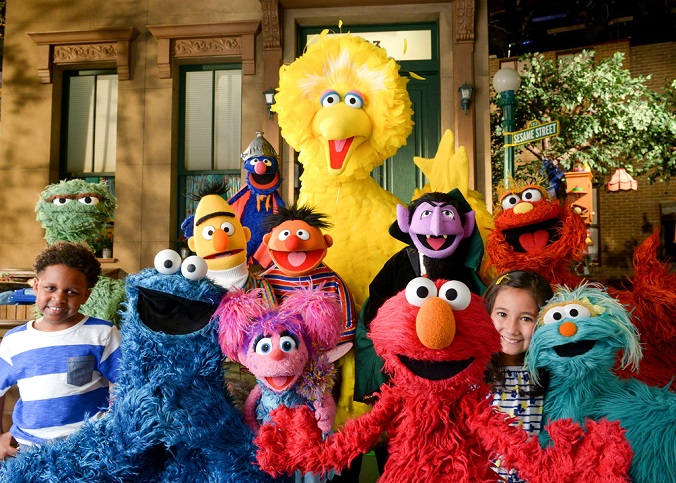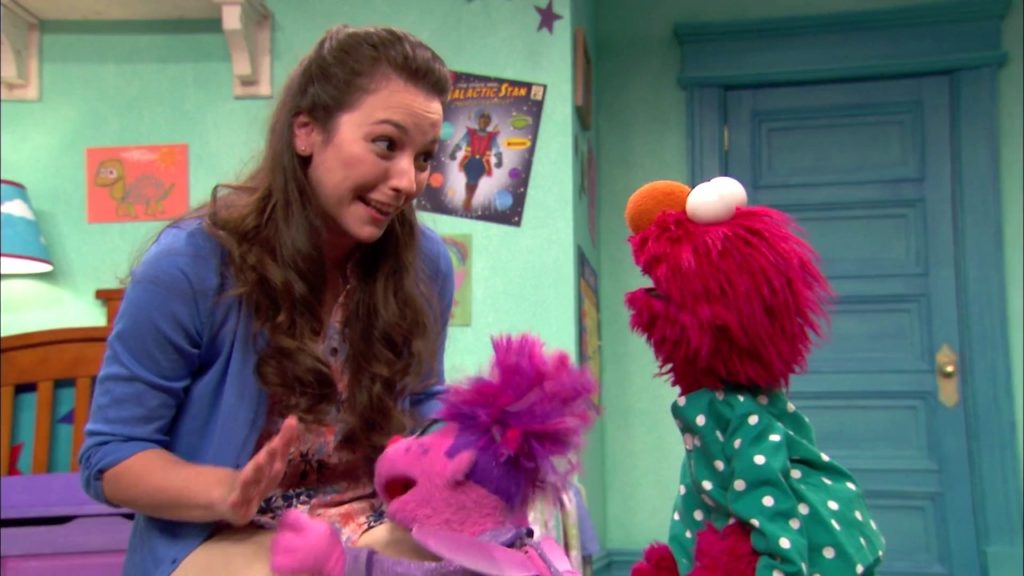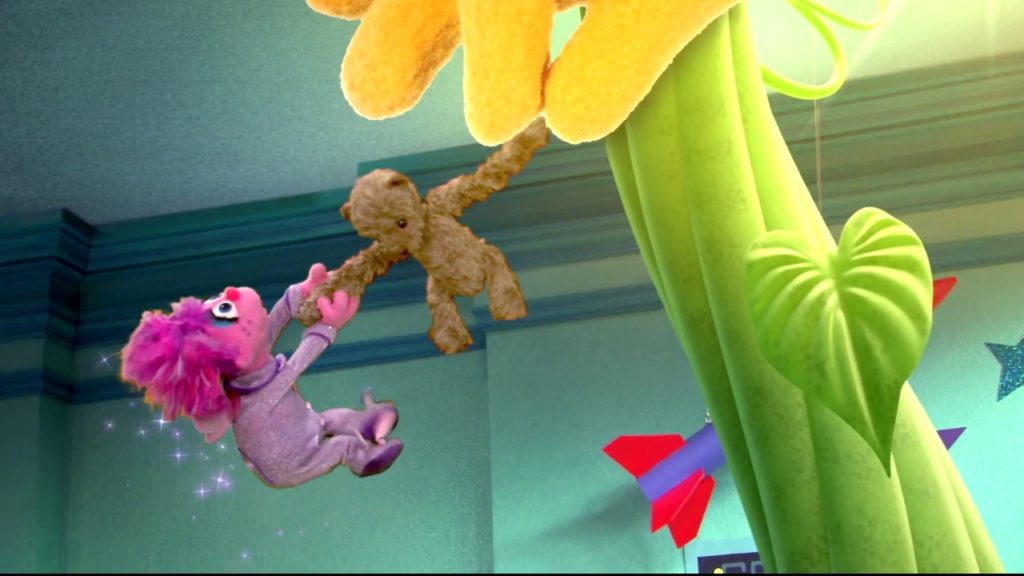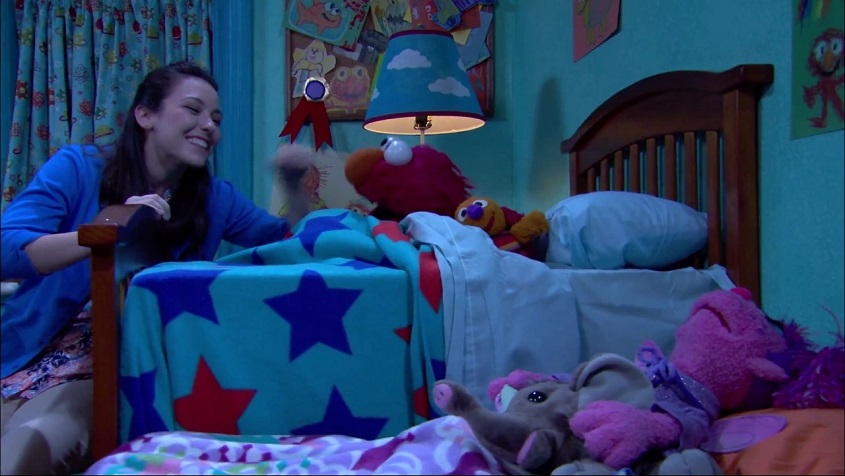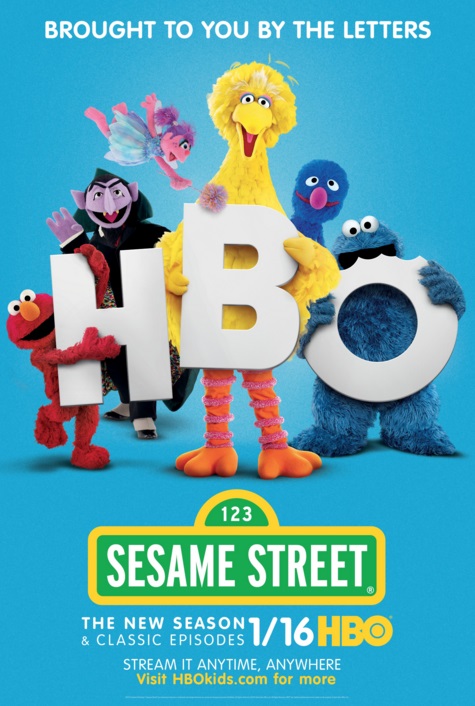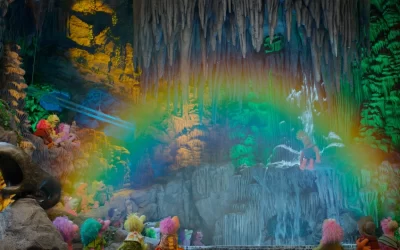Season 46 (January 16, 2016 – October 29, 2016)
Today’s review was written by Tough Pigs’ own Peter Papazoglou. Thanks, Peter!
A Tale of Two Sleepovers: When a television show runs over 4,000 episodes, it’s bound to have more than its share of bright spots, some clunkers along the way, and a whole lot of in between. Sesame Street, famed for its rigorous research, even made one episode (“Snuffy’s Parents Get a Divorce”) that tested so poorly it was never aired.
Still, I never expected that I’d see an episode of Sesame Street that I found so misguided – so objectionable – that I wouldn’t let my children watch it.
The premise of the Season 46 premiere, “Bedtime Story,” sounds ordinary enough. Abby is sleeping over at a friend’s house, and one of the street’s resident humans is along for the ride to help the pair with their nighttime routine. It’s familiar territory for the show, which ran a similar plotline in Season 39’s “Abby’s First Sleepover,” a favorite in my house.
But watching the episodes back-to-back, I felt an enormous distance between them. The show had changed. And not in the ways we’re used to talking about the show changing. In the prior 45 years, so much had come and gone: characters, locations, recurring sketches, programming formats… But what hadn’t changed was the way Sesame Street talked to kids: with respect, always letting them know that they were ok just the way they were, both on the outside and deep down inside. Until now.
In order to highlight what Sesame Street gets so wrong with “Bedtime Story,” I think it’s important to show what it had gotten so right about “Abby’s First Sleepover” seven seasons earlier.
In “Abby’s First Sleepover,” we find Abby getting ready to spend her first night away from home at Big Bird’s nest. At first, she seems prepared for her nighttime routine; she’s brought her blanket, her pillow, and her book of bedtime stories. But when she realizes that Big Bird doesn’t know how to read, the fairy frets. “But my mommy always reads to me at bedtime!” Luckily, Maria and Luis, passing by en route to a night of dancing, are sweet-talked into helping out. “How long can reading a story take?”
Of course, Abby’s bedtime routine isn’t exactly what Maria and Luis expected. Before the story can begin, Abby needs her wings brushed – with a special brush that has to be couriered by the Magic Fairy Delivery Service. When she needs to be tucked in, it’s on a floating pillow that zigs and zags, just out of reach of her magic blanket. And when it’s finally time for the story, Abby conveniently forgets to inform Maria that “when you read a rhyme” from her magic nursery rhyme book, “the rhyme happens” until after a space helmet-clad cow from “Hey Diddle Diddle” has crash landed into Big Bird’s pad.
All in all, it’s a pretty noisy affair. But Maria handles it with her usual aplomb, respecting and adapting to Abby’s routine while insisting that they don’t linger on any one step too long, all while displaying her signature mix of delight at the fanciful proceedings with the kind of exasperated side-eye that makes a parent feel seen.
Cut back to Season 46.
As I mentioned, the premise of “Bedtime Story” is very similar. This time, Abby is staying at Elmo’s house. And the particulars of her bedtime routine, while still magical, are a bit different. Instead of a wing brush, she has a fairy toothbrush that does all the brushing – if she can catch it. Instead of her magic blanket and pillow, she has a stuffed bear – if she can wrest it back from Jack’s Giant in a game of tug-of-war played on a magic beanstalk. And instead of a bedtime story, she has a lullaby – played by a marching band.
What’s really different, though, is the babysitter. Or, rather, the babysitter’s response to Abby’s routine.
Nina, in her very first appearance on the show, seems shocked and appalled by Abby’s bedtime routine. She repeatedly scolds Abby, instructing her at every juncture that her routine is “not a good way to calm down before bed.”
Nina intercepts the flying fairy toothbrush and encourages Abby to brush her (admittedly nonexistent) teeth with a regular toothbrush like Elmo, even though Abby insists “my fairy toothbrush always brushes my teeth for me.”
Nina interrupts Abby’s game of tug-of-war with Jack’s Giant, claiming that “it gets you too excited” even though Abby and the Giant “play tug-of-war every night.” Elmo instead shares one of his stuffed toys for Abby to pat on the head calmly. After all, she can’t pat her own; as a result of Nina’s intervention, “the Giant has my teddy bear.”
And finally, Nina insists that Abby’s favorite lullaby (which she conjures with the spell “Lullaby! Lullaby! Lullaby!”) isn’t a lullaby at all.
“I guess my fairy bedtime routine is not very good at calming me down,” Abby concludes. Despite the fact that she ostensibly manages to fall asleep every night with this bedtime routine at home.
And there you have it. In eight short minutes, one of the grown-ups on Sesame Street has convinced one of the children that their way of being in the world is wrong. Sesame Street, which managed to run for 45 seasons without ever telling Oscar the Grouch that he needed to stop being grouchy or Cookie Monster that he needed to give up cookies or Elmo that he needed to start using pronouns.
Back in “Abby’s First Sleepover,” it’s not that Maria likes all of Abby’s requests. She even tries to find a few shortcuts, only to be reminded by Big Bird that “it is a routine.” Poor Luis is even more exasperated, reminding everyone throughout how much he wanted to go dancing.
Still, they both find a way to meet Abby where she is while maintaining their own subjectivity, clearly communicating that there’s nothing wrong with what feels normal to her. And in the end, that’s what helps Abby and Big Bird make a really big adjustment to their routine when a storm forces the sleepover to move indoors.
So what happens when Nina demonstrates neither Maria’s upbeat (if occasionally begrudging) flexibility nor Luis’s more obviously frustrated (but resilient) patience? What she communicates to Abby is not that there are other good ways to fall asleep or that sometimes we need to adjust our behaviors in new environments, but that what she’s come to know as normal isn’t acceptable.
What message could be more damaging to a developing child?
I know I sound like I’m overreacting. I know I do.
But because I’m married to a super smart educator, I know that the ability to learn something new is motivated by two things: value (in other words: “this is worth learning”) and efficacy (in other words: “I can do this”). That second component goes to the heart of self-esteem, especially in young children. And decades of research – the kind I’d expect Sesame Street writers to be familiar with – show that it’s hard to overstate the importance of self-esteem to a child’s ability to learn or the potential for poor self-concept, shame, and disapproval from parents or peers to obstruct the motivation that makes learning possible.
So how did Sesame Street get here?
Well, it’s probably time to talk about the elephant in the room. And it’s not Fluffy or Horatio. “Bedtime Story” isn’t just the first episode of Season 46 or Nina’s first appearance on the show. It’s the first episode to air exclusively on HBO nine months before it became available to the general public on PBS. In the first full season to be produced under the supervision of Sesame Workshop’s new CEO. In a new, shorter, half-hour format. It’s also the first season to air after the departure (at least some of them involuntary) of seven beloved adult characters – characters we trusted and relied on to speak to our children with respect in ways that helped them learn.
That’s a lot of change. Big change. And I know it’s not possible to pinpoint what went wrong to one of those changes or even any of them at all. But what I do know is that somewhere between Seasons 39 and 46, something did go wrong. Sesame Street lost its way and ended up telling a “Bedtime Story” I wouldn’t share with my children.
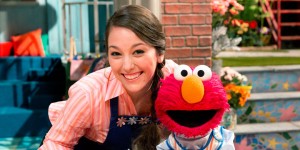 Notable Character Debut: Nina’s new. And notable. And if a flying toothbrush before bedtime is enough to set her off that badly, she’s probably not going to like living on Sesame Street that much.
Notable Character Debut: Nina’s new. And notable. And if a flying toothbrush before bedtime is enough to set her off that badly, she’s probably not going to like living on Sesame Street that much.
Notable Character Departure: Most of our favorite humans technically departed the show at the end of Season 45 (Roscoe Orman’s Gordon has one final cameo this year). But Season 46 is Joey Mazzarino’s last as both head writer and a performer. Which means Murray made his final appearances this season as well, even if they’re only in group numbers. It took a while for Murray to grow on me, but Mazzarino had a tremendous ability to connect with children through the character, especially in the “Murray Has a Little Lamb” segments. Even though Murray seldom appeared in street stories or sketches, he made a real impact on the show.
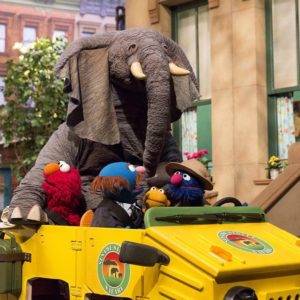 MVE (Most Valuable Episode): This season has definitely upped the production value, introducing new sets, putting the characters in elaborate costumes (“Halloween,” “When Dinosaurs Roamed Sesame,” “Dress-up Club”), and piling on the CGI (“Sesame Ocean,” “Smart Cookies”). And sometimes it feels like the characters and stories are getting lost in it.
MVE (Most Valuable Episode): This season has definitely upped the production value, introducing new sets, putting the characters in elaborate costumes (“Halloween,” “When Dinosaurs Roamed Sesame,” “Dress-up Club”), and piling on the CGI (“Sesame Ocean,” “Smart Cookies”). And sometimes it feels like the characters and stories are getting lost in it.
My favorite episode of the season, “Grover’s Street Safari,” is so simple it feels like a throwback in comparison. The episode finds Mr. Johnson joining Safari Grover as they explore Sesame Street in search of wild animals, donning monkey and elephant costumes to lure them out of hiding in Mr. Hooper’s Store and the community garden. Well look at that, the show managed to dress up the characters and show off its new sets in this episode after all. But the effects are practical, and the relationship between the central characters is as rewarding as ever. Plus, there’s a terrific little song you won’t be able to get out of your head…
Musical Highlight: “We’re Going on Safari” is the most infectious ditty I’ve heard on Sesame Street since “Keep on Cluckin’” from the “Circus the Musical” episode of Elmo the Musical in Season 43. Not surprisingly, they both have music by JP Rende and Kathryn Raio-Rende. “We’re going on safari / in our safari car-y / we don’t have to travel far-y / on our Sesame Street Safari!”
Classic Sketch Debut: I don’t know that I’d call “Smart Cookies” a classic sketch, but it’s worth noting since it’s the only new recurring segment introduced this season. “Smart Cookies” follows a team of crime fighters – a trio of new Muppet Cookie characters joined by a new rookie, Cookie Monster, who struggles to remember to “stop and think things through.” It feels like this is supposed be part of the self-regulation curriculum that worked so well for the character in the Crumby Pictures sketches. But the tie-in to self-regulation is much looser here, coming into play mostly when Cookie Monster needs to avoid eating his teammates.
Most of the time, he’s making the kinds of repetitive, obvious, out-of-character mistakes that, frankly, make him look like an idiot. Come to think of it, it might have been a better fit for easily distracted, always in a rush Grover. Anyway, I’m not surprised the segment doesn’t last beyond Season 47.
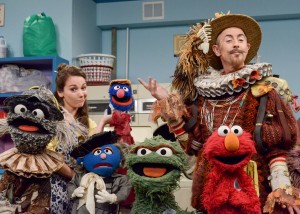 Best Celebrity Moment: Alan Cumming as Grouch Explorer Mucko Polo is pretty fun. But what really stands out is his costume, which appears to have been constructed entirely out of actual trash. Kudos especially to the designer and builder of the neck ruffle made of newspaper.
Best Celebrity Moment: Alan Cumming as Grouch Explorer Mucko Polo is pretty fun. But what really stands out is his costume, which appears to have been constructed entirely out of actual trash. Kudos especially to the designer and builder of the neck ruffle made of newspaper.
WTF Moment: Do I really need another one? Oh, all right. I nominate “The Walking Gingerbread,” a parody of the The Walking Dead. The zombie gingerbread boys and girls totally creeped my kids out. Definitely my kids. Yup, just them. Seriously, though, WTF? This is the most unsettling parody since “True Mud.”
One More Thing: Apparently, this is the first time the opening theme song has been performed on the actual Sesame Street set. It’s also the first time the concept for the sequence was “Look! We have really fancy new cameras.”
Okay, One More Thing: I haven’t talked much about the new half-hour format yet. I get the reasons behind the change and agree that a full hour was asking a lot of both kids’ attention and parents’ time. But it really does feel like we’re plowing the material now. The first time my five-year-old saw the intro for Elmo’s World pop up, she literally said “Awww, man! It’s over already?”
Click here to brush your non-existent teeth on the Tough Pigs forum!
by Peter Papazoglou

